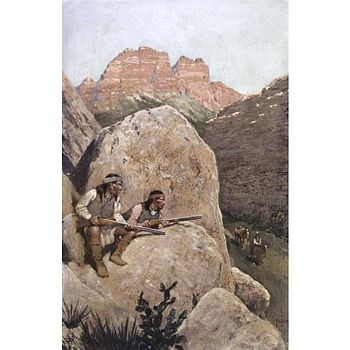| Post-1887 period | |||||||
|---|---|---|---|---|---|---|---|
| Part of the Apache Wars | |||||||
 Renegade Apaches by Henry Farny | |||||||
| |||||||
| Belligerents | |||||||
|
| Apache | ||||||
The post-1887 Apache Wars period of the Apache Wars refers to campaigns by the United States and Mexico against the Apaches.
After the surrender of Geronimo in 1886, Apache warriors continued warfare against Americans and Mexicans. The 10th Cavalry and 4th Cavalry forces under First Lieutenant James W. Watson pursued mounted Apache warriors north of Globe, Arizona, along the Salt River. Sergeant James T. Daniels, Company L., 4th Cavalry and Sergeant William McBryar, Troop K., 10th Cavalry, are the last-known recipients of the Medal of Honor for actions during the Apache Wars. Both were cited for "extreme courage and heroism" while under attack by hostile Apaches, on March 7, 1890. Sergeant Y. B. Rowdy, Troop A, of the Indian Scouts, was also decorated with the medal on the same date.[1]
The last Apache raid into the United States occurred as late as 1924 when a band of natives stole some horses from Arizonan settlers. The Apaches were caught and arrested.[citation needed][2][3][4]
The Mexican Indian Wars that involved Apache bands in Northern Mexico continued for another nine years, until the final holdouts were defeated in 1933.[citation needed]
- ^ Melzer, Richard (2007). Buried Treasures: Famous and Unusual Gravesites in New Mexico History. Sunstone Press. p. 285. ISBN 978-0-86534-531-7.
- ^ Clare V. McKanna, Jr. (February 2000). "Apache Kid". American National Biography Online. Oxford University Press. Retrieved 2012-06-21.
- ^ "Indian Wars in Arizona Territory" (PDF). Arizona Military Museum. Retrieved 2022-05-23.
On September 3, 1886, the wily war chief surrendered and the Apache Wars were finally over.
- ^ Paul, Lee. "Massai and the Apache Kid". Old West Legends. Archived from the original on 2010-06-24. Retrieved 2011-08-20.
In early September 1906, a New Mexico posse determined to put an end to the depredations. They followed a trail of stolen horses along the north rim of Wild Horse Canyon, across Alamosa Creek, and up a canyon that headed northeast up the San Mateo Divide. On the morning of 6 September 1906, they ambushed two Indians at the head of San Juan Canyon.
